
After our visit to ARCO, we traveled to visit Clayco for the remainder of the day. Upon arrival at the Clayco office, we were provided with a delicious lunch that was followed by presentations from several members of the company. Each member represented a separate entity of Clayco and helped us gain an insight to the company as a whole.

Steve Moeller-Forum Studios: V.P. of the Technical Assurance Group (TAG): As a part of Forum Studios, TAG is responsible for several quality assurance and quality control aspects within Clayco, and can also be contracted as consultants for outside firms. Additionally, they provide insight from the perspective of an architect for all facets of a project from design through turnover. Also, TAG helps to provide a quality design-build project which, as Steve put it is, “the biggest bang for the client’s buck.” TAG often visits project sites to help clarify design strategies used on the construction site for the operations team.
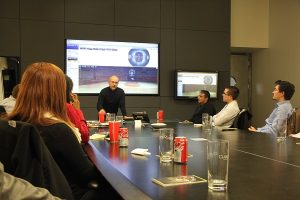
Chris Hamilton- Director of Safety: The safety presentation began with Chris showing us the monthly safety report that Clayco regularly distributes to its employees. Clayco takes great pride in their safety program to prevent potential injuries to workers on their jobsite. Safety is important in order to provide a work environment that allows workers to “go home the same way that they showed up.” Clayco is currently pursuing accreditation for OSHA VPP (Voluntary Protection Programs), which recognizes firms who have implemented safety and health management systems and maintain injury and illness rates below the national average for their industry.
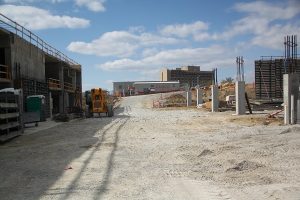
Chip Crawford-Forum Studios, Senior Principal: Forum Studios is an architectural design firm that performs both in-house work with Clayco’s design-build projects, along with contracted work for outside clients and contractors. Forum Studios, comprised of about 70 architects and engineers, plays a significant role in Clayco’s ability to successfully deliver design-build projects. Forum Studios provides design services for essentially every project type and even master planning, such as a city layout.
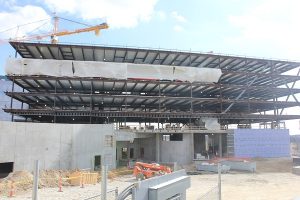
Tomislav Zigo – Director of Virtual Design and Construction (VDC): An important question raised by Tomislav was, “When does a project end?” While some say it ends when the keys are given to the client, Clayco believes otherwise. Many firms use BIM as a computerized model, but Clayco utilizes BIM as a means for VDC that will assist a client over the lifespan of a project. VDC synchronizes the project’s design with the associated cost for materials, duration to complete activities, and other field operations. Beyond construction, VDC can be used to track energy consumption, identify building service requirements, and to help increase a building’s life cycle. Tomislav explained how Clayco already utilizes BIM to provide real-time information to the project superintendents. Furthermore, Tomislav alluded to the future uses of BIM such as laser scanning to generate a point cloud surface for As-Builts, QA, and QC services with an automated drone.
Barclay Gebel – Concrete Strategies, Vice President of Operations: Concrete Strategies is the self-perform segment of Clayco that provides solutions such as tilt-up construction, structural foundations, precast, and even steel erection. Concrete Strategies will self-perform work on Clayco projects, but also pursues work for other contractors. It is comprised of about 300 field employees, and started as a tilt-up construction company. Barclay described how Concrete Strategies is unique to the rest of Clayco since they are comprised of field employees, who have other concerns like maintaining workflow, cost, schedule, and safety.
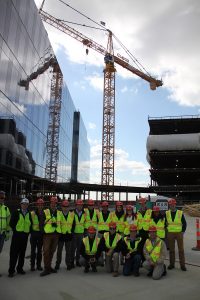
Following the visit to the office, we drove to the RGA Corporate Headquarters project. Clayco is building a two-tower facility for the Reinsurance Group of America (RGA) in Chesterfield, MO that is seeking LEED Gold certification. The two 5-story towers and central outdoor atrium amount to a 405,000-square-foot complex with a 1,400 vehicle parking facility. The core&shell of the building is valued at about $140 million and will be followed with a tenant fit-out. The project is anticipated to be completed by the fall of 2014.
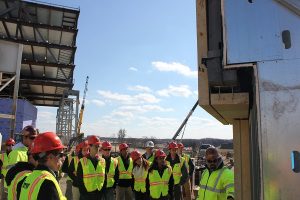
Bob Eidson, assistant superintendent, and John Elizarraras, superintendent, took us on a tour of the jobsite. Many of the difficulties with the project arose from the harsh winter weather this year. Bob estimates that they have experienced about 72 weather days since he joined the project in March of 2013. Weather issues such as cold and wind have restricted the ability of the project team to perform several tasks. For example, the curtain wall glass system could not be installed during high wind weather, which included the day of our visit. Other tasks such as spray-on waterproofing and the roofing needed to be completed under dry, warm conditions. These water-based products needed at least 40 degree weather in order to ensure proper application.

An interesting component of the project was the glass system. The first floor glass was stick built, but the remaining floors were panelized systems. The panelized systems were raised with a crane with a spreader bar. The panels interlocked during installation and required minimal additional work outside of sealing the gaskets. For the first tower, it took approximately 1.5 months to install the glass panels with a production rate of 35-40 panels/day.
Part of the building’s design included a 40′ section that cantilevered off the edge of the building. A tower structure was used as temporary shoring to support the cantilevered section. After the concrete and glass system was added to the structural frame, hydraulic jacks were used to raise the temporary shims from beneath the cantilevered section. As part of the building’s design, the cantilevered section dropped by about 1-1.5″.
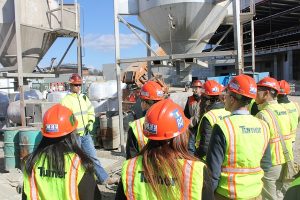
Overall, the project will surely suit the needs of a Fortune 500 company such as RGA. We are thankful for each of the Clayco employees who took the time out of their day to host us. In particular, we appreciate the efforts of Frank May and Steve Street for organizing our day’s events.
Blog by Kevin Chua
